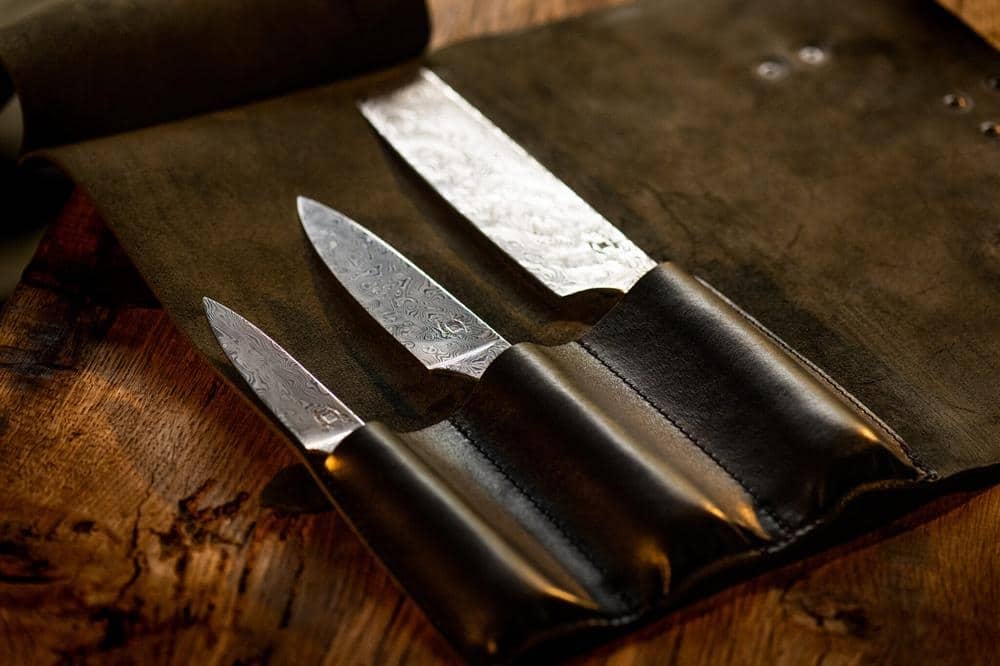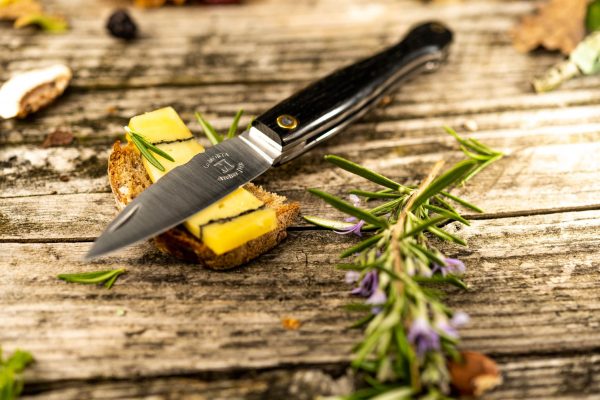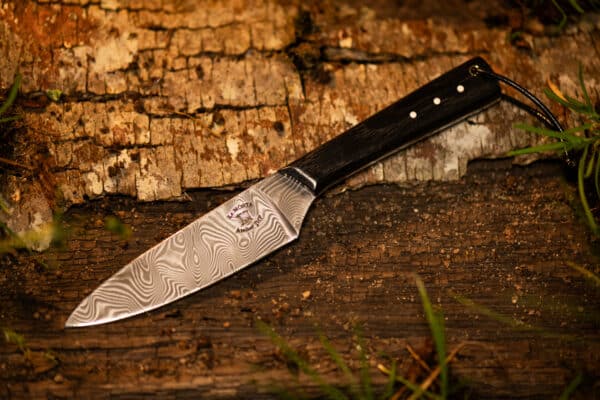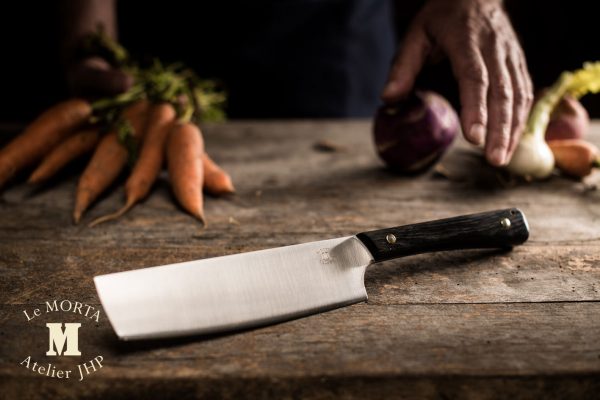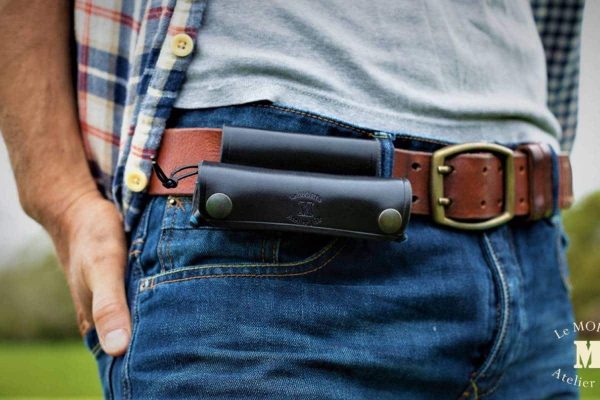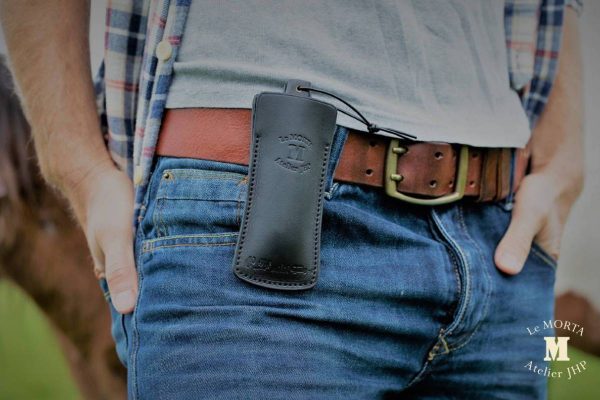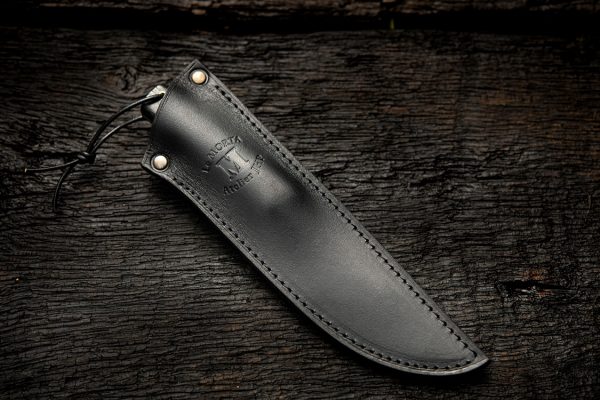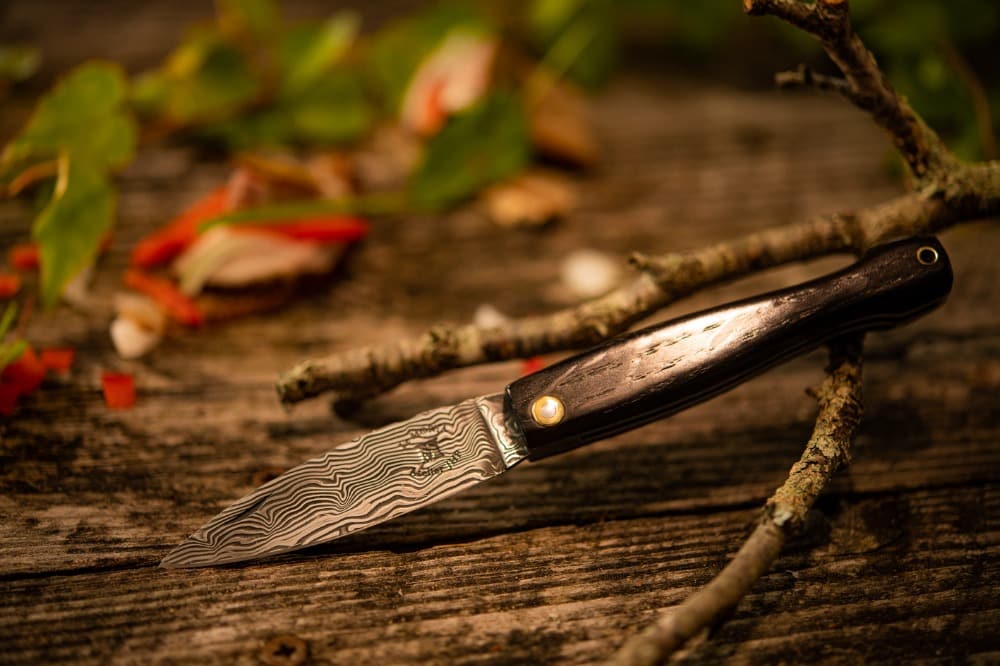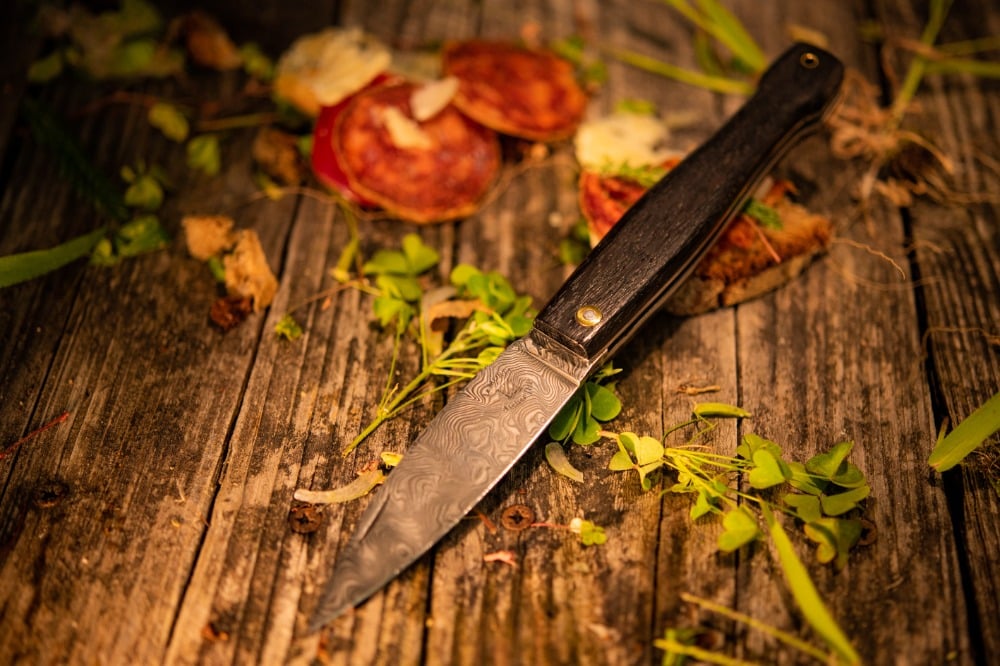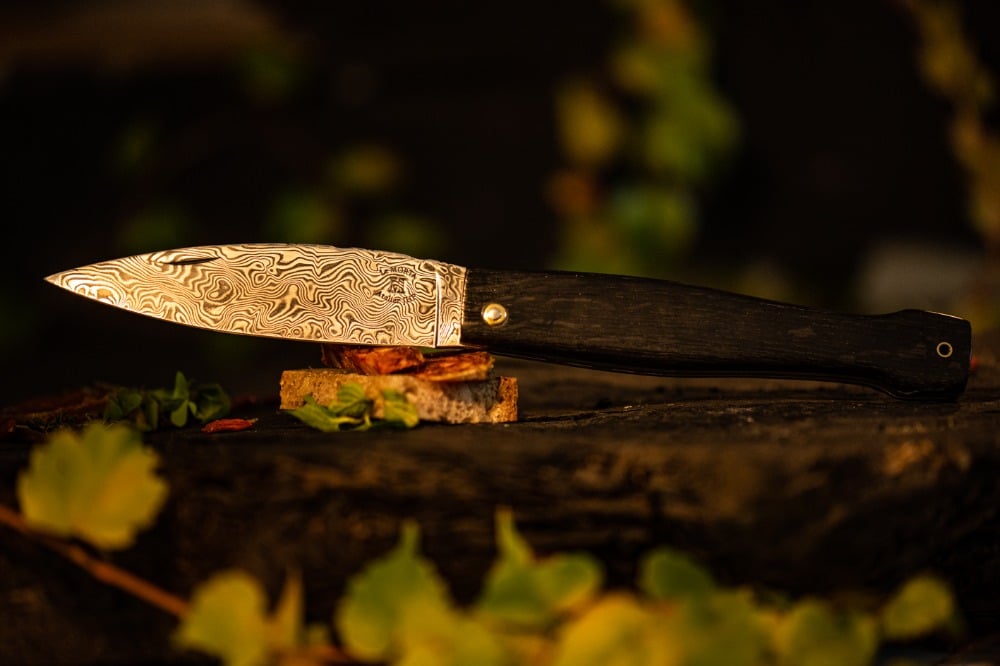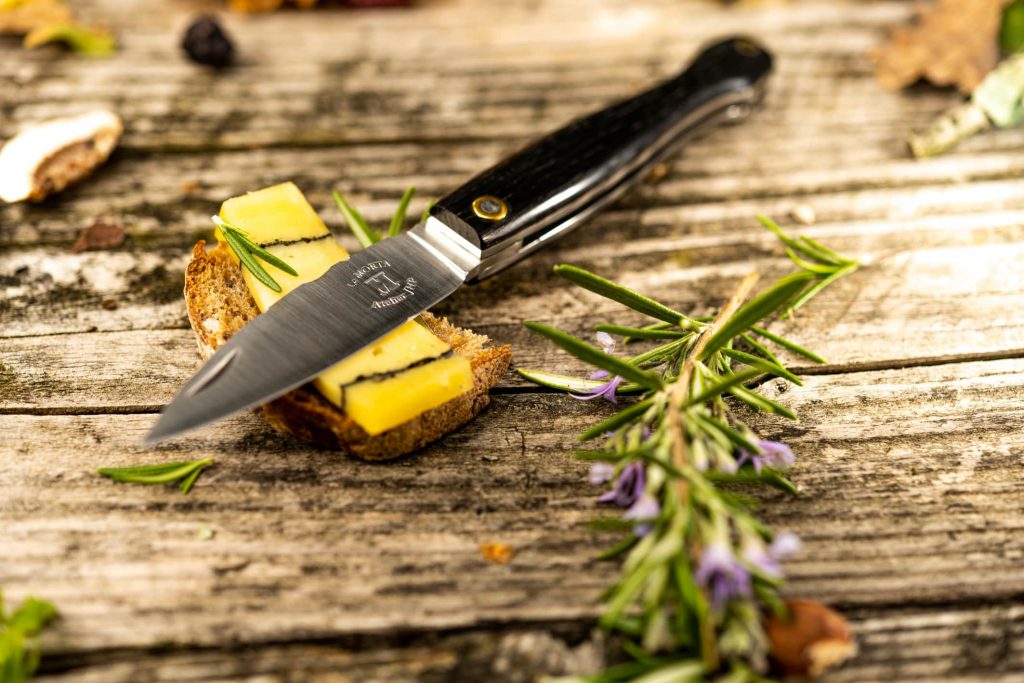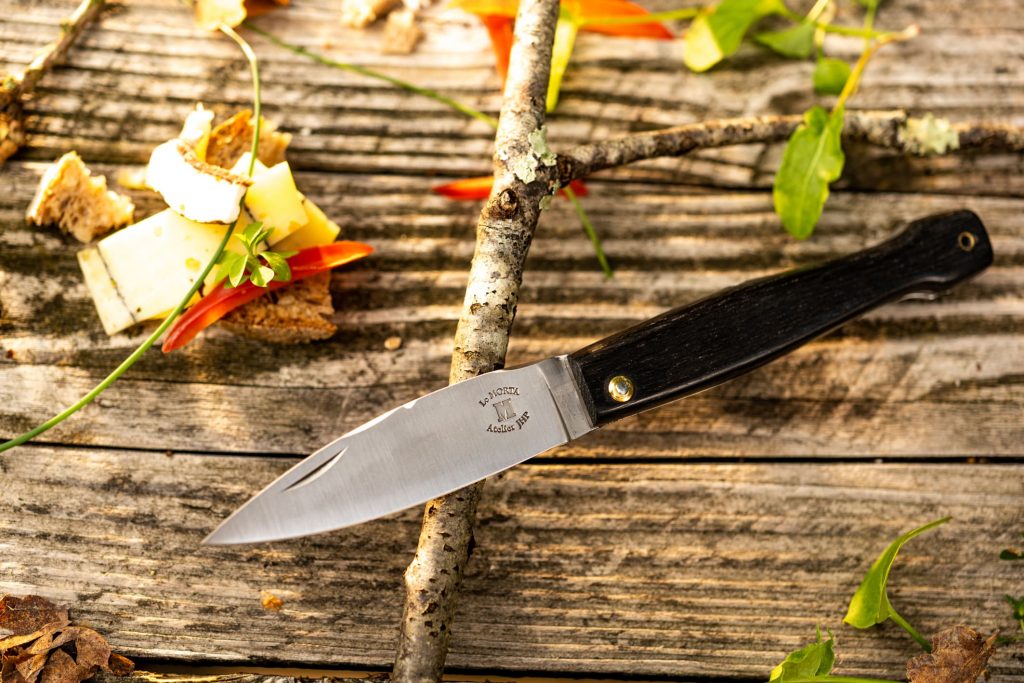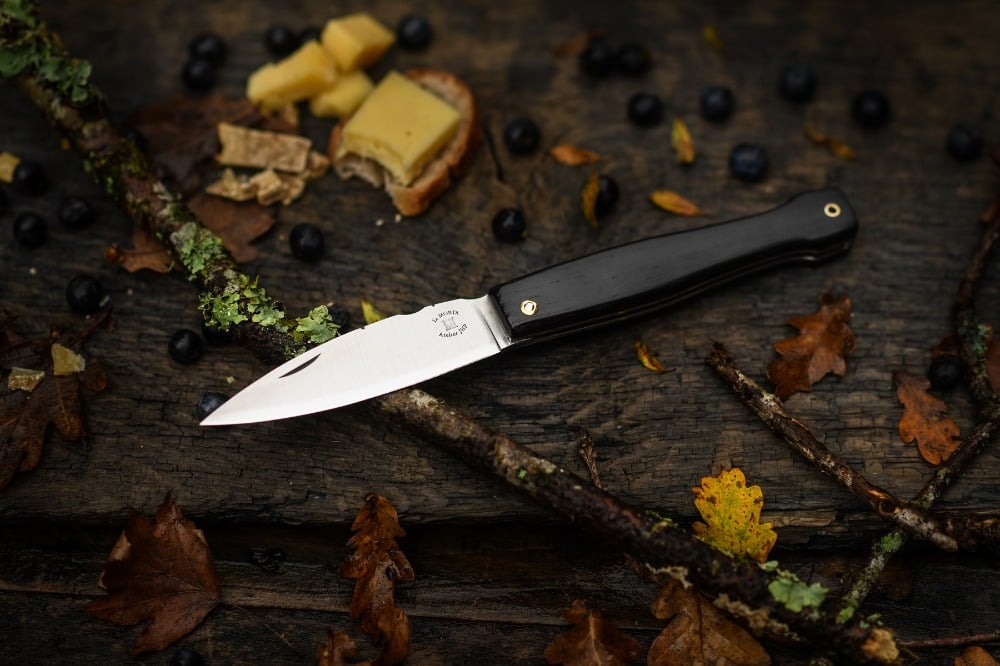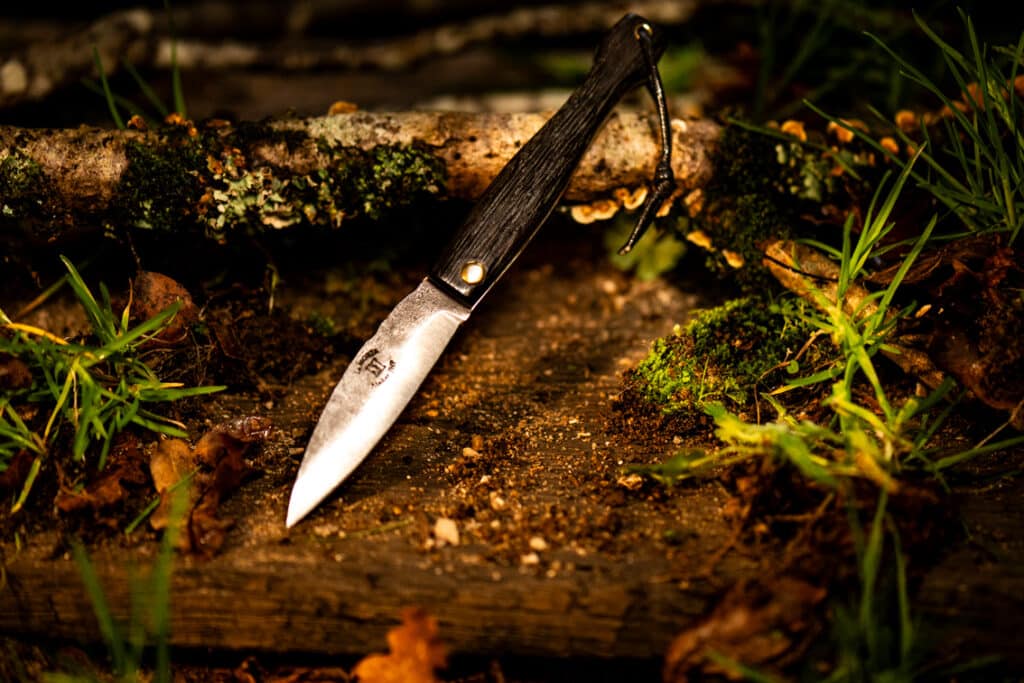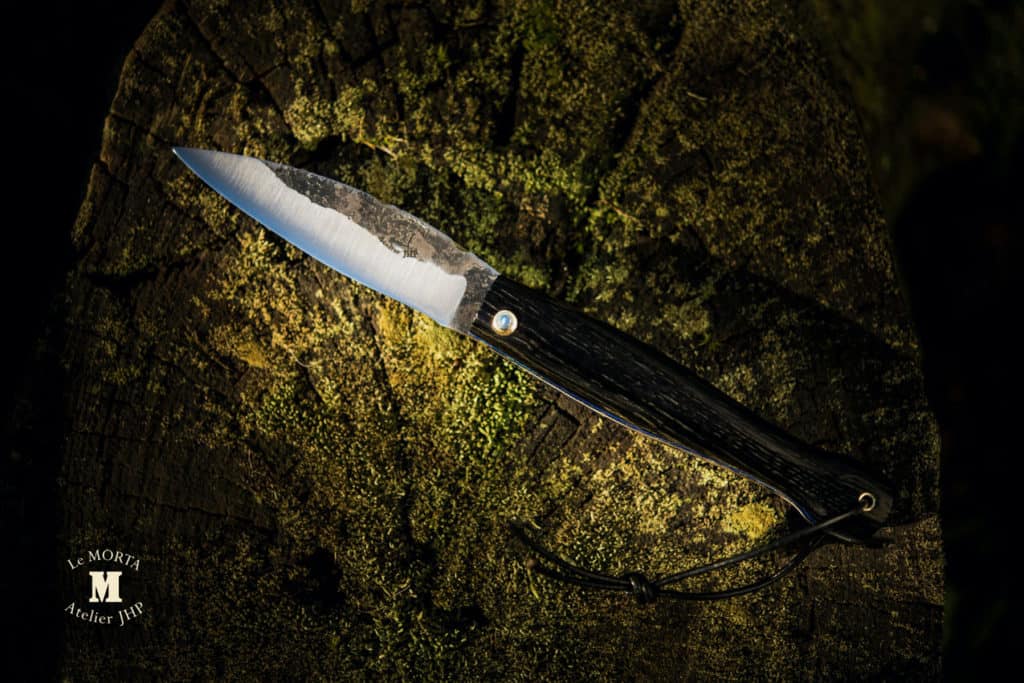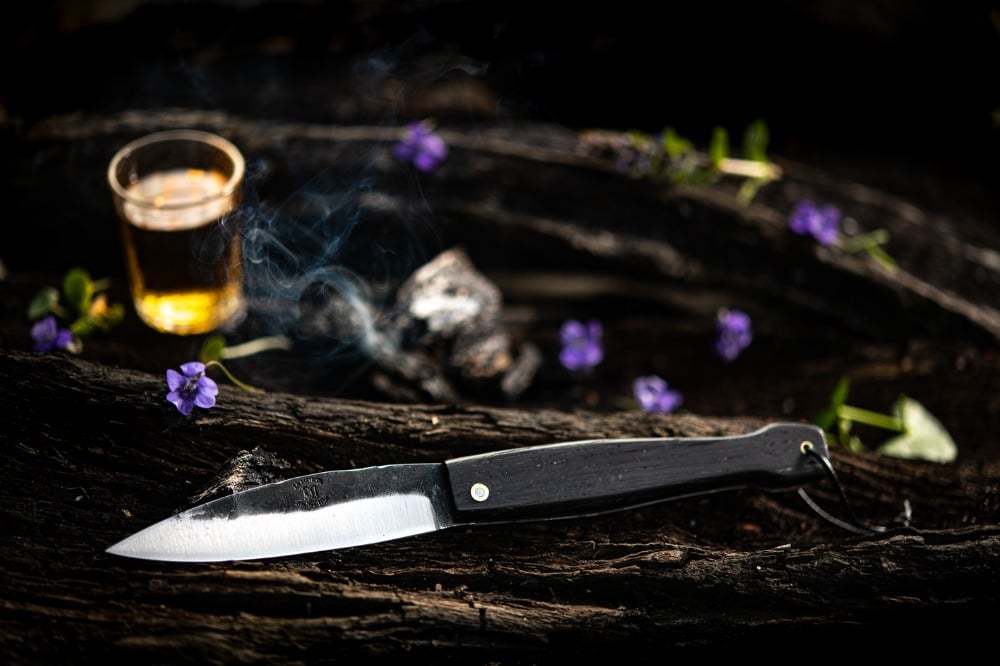“Made in France” is the antithesis of planned obsolescence,” proudly states Charles Huet, co-founder of the Independent Federation of Made in France. The supremacy of the blue, white, and red logo is affirmed in craftsmanship, notably in cutlery. Choosing a knife made in France means acquiring an item of artisanal manufacture, with perfect finishes, quality steel combined with a solid and comfortable handle.
Today, consumers want local and responsible products. Goodbye to consumerism, hello to reasoned, committed, and meaningful purchases. The Made in France knife, a centuries-old tradition, a symbol of memory and transmission. Fixed or folding, kitchen or pocket knife, the tricolor range exhaustively meets the needs and desires of a demanding clientele, because they are connoisseurs of fine blades.
The Advantages of a Made in France
Knife Artisanal Quality
Regardless of the French region of origin, a cutler pays great attention to the choice of materials. This affects their reputation in terms of aesthetics, durability, and the knife’s sturdiness coming out of their workshop.
The special attention given to the finishing work demonstrates the seriousness and commitment of French cutlery artisans. It is found in the comfort and pleasure when the handle fits the palm of the hand.
A Blade: Quality Steel
From stainless steel to Damascus blades, the cutler carefully chooses the steel to meet the need for corrosion and breakage resistance. The perfection of the cutting edge also depends on this wise selection: a delicate osmosis of technique, innovation, and tradition.
Damascus steel, the must-have for high-end knives, is obtained through classic forging or powder metallurgy. At Couteaux Morta, we combine RWL34 and PMC27 steels for a moiré aesthetic finish close to artwork and a hardness of 60 HRC Rockwell.
I discover Damascus blade knives 🔪
A quality blade is hot-forged for a solid, heavy visual without welding points.
Discover knives with forged blade 🔪
Chef and kitchen knives come with stainless steel or Damascus blades. It’s a matter of emotion and personal appreciation.
The Handle: A Local Wood Tradition
Consume less, but better. Thus, new purchasing habits emerge, such as being flexitarian. A French product, through the committed expertise and quality materials used, offers a perfect combination of passion and culture. Should one really compare an industrial product made-in-unknown to a product made with materials, labor, passion, and French know-how?
Which wood is best? Choosing a wood species is logical. The wood is chosen for its natural, authentic approach, and the rustic aspect so appreciated by lovers of beautiful knives. The wood provides an unparalleled sensation compared to handles made of plastic or composite materials from petrochemistry. But all this is a matter of taste, of course. Some opt for handles made of horn or bone.
Among the local species suitable for knife making, you will find olive, birch, boxwood, or juniper. This is for standard French knives. And what if we talked about quality French knives, of tradition and history?
Morta is a wood found only in Brière. 5,000 years ago, a geological upheaval buried a vast oak forest in the black peat. This served as a natural sarcophagus for the trunks, which slowly fed on the sediments. That’s why Morta, still undergoing fossilization, offers this brown hue with some caramel reflections today. The pieces carefully selected by the cutlers present an incomparable character. To grasp 5,000 years of history in hand to use one’s knife is a true privilege.
Did you know? Morta knives are handmade and guaranteed for life 🔪
But a knife is also a symbol of family tradition and heritage. This is evidenced by its emotional dimension.
Let yourself be tempted by our Made In France products… ✨
-

Mini solid Morta
120,00 € This product has multiple variants. The options may be chosen on the product page -

Compact fixed damascus knife
340,00 € This product has multiple variants. The options may be chosen on the product page -

Stainless steel chef’s knife
280,00 € This product has multiple variants. The options may be chosen on the product page
History of the French Knife: Tradition and Heritage
The story of the knife in France
We would gladly talk about famous French events involving the use of the knife. The assassination of Marat in his bathtub by Charlotte Corday or that of Henri IV by Ravaillac. But the history of the knife goes much further back.
It begins some 2.7 million years ago with flint, in the Paleolithic era, which means “chipped stone.” Man then begins to chisel his tools. Gradually, bronze and then steel replace flint to manufacture blades. Until the 9th century, it was the blacksmith, the farrier, or the ironworker’s task to manufacture this utensil, the knife.
Then, cutlers appear: specialized craftsmen who combine the two expertise, the work of the blade and the wooden handle.
Key Historical Milestones of French Cutlery
| Xe siècle | Emergence of table knives (chef’s knife, kitchen knife) |
| XIVe siècle | Introduction of noble materials for the handle (precious woods, gold, silver, enamel, horn) |
| XVe siècle | Rise of cities and cutlery centers such as Beauvais, Périgueux, Toulouse, Langres, Paris, Thiers, Châtellerault, Moulins, Saint-Étienne. Saint-André-des-Eaux? Oh, that’s a bit later, let’s stay patient… 😉. Artisan cutlers establish an ethical charter that governs production, brands, and territories in the form of a guild. |
| XVIIe siècle | Development of cutlery for table use. Scissors and specific knives for the kitchen and food trades become popular and increasingly find their way onto tables. |
| XIXe siècle | French cutlery gains international renown. The profession becomes more accessible with the Le Chapelier law in 1791, which allows any artisan to enter the trade. Preceded by the Allarde decree*, it promotes business freedom at the expense of guilds. *Decree relating to assemblies of workers and artisans of the same state and profession. |
The Cutlery in France: Key Figures of a Dynamic Economic Sector
Cutlery includes the manufacturing and marketing of knives and sharp objects for individuals and professionals.
Today, French cutlery:
- involves 120 main manufacturers;
- employs 1,600 people;
- shows a growth of +10% between 2018 and 2022.
🔪 The sector mainly consists of very small enterprises (TPEs).
To date, the French predominantly buy table knives (38% of purchases) and pocket knives (27%). Industrial trade knives, kitchen knives for individuals and professionals share the remaining 35%.
Observatory notes that customer expectations lean towards Made In France and responsible sourcing. Maintaining skills and cutlery know-how is a major challenge for the sector.
Why Buy a Knife Made in France?
Support the Local Economy
After the era of globalization and low-cost (or at any cost 😉), French consumers are returning to short supply chains. The “transport costs” versus “cheap labor” arm wrestling favors local purchases. Quality wins over quantity.
Paying for a blue, white, and red product also means buying down the street and not across the globe, according to a slogan that emerged during COVID. If there is a price difference, the consumer considers it an investment in a better national economy.
Buying French means moving away from pure consumerism. It gives meaning and a broader perspective to an everyday action.
Charles Huet.
The FIMIF (Independent Federation of Made in France) calculates that transferring 10% of French purchases to domestic products would generate the creation of 150,000 jobs per year.
Enough to fuel eco-citizen motivations.
Buying Ethically and Responsibly
Cheap labor, we know, rhymes with the violation of human respect. Social standards, legal age, decent wages are notions many consumers now refuse to endorse. A knife made in France inherently respects the Labor Code.
Protecting the Environment
Environmental protection increasingly ranks in the race for smart purchasing. Buying French drastically reduces transport costs, thus the product’s carbon footprint.
Did you know? At Couteaux Morta, we only use local wood, buried in the Brière soil about 1,500 meters from our cutlery workshop. This wood is Morta (QED). 🔪
Our extraction method is designed to preserve fauna and flora. It is carried out in partnership with the Commission Syndicale de la Grande Brière Mottière, the Brière Regional Natural Park, and biodiversity services.
Our suppliers are all located in France, most of them in the Pays-de-Loire region.
So, shall we really calculate that carbon footprint?
Rediscovering Meaning in Purchasing
The health crisis revealed the vicious cycle of overconsumption we were victims of. The post-2020 years return to a simple and reasoned way of life. This is evidenced by numerous career changes and the desire for a balance between personal and professional life. Buying has now become a civic gesture. This trend is observed in the toy and textile sectors as well.
According to the MIF guide, 93% of French people believe buying a product made in France is a way to support local companies. What about the remaining 7% 🤔?
Finally, last but not least: we buy French because it pleases us. Right? Well, a touch of protectionism can’t hurt 😉.
Made in France Certifications and Labels
French-Origin Manufacturing
Labeling products with the Made in France mark is not mandatory in cutlery. However, the tricolor label resonates with quality, prestige, and transparency. Many knife manufacturers, like those of any other artisanal product, use it as a commercial argument, a guarantee of quality and authenticity.
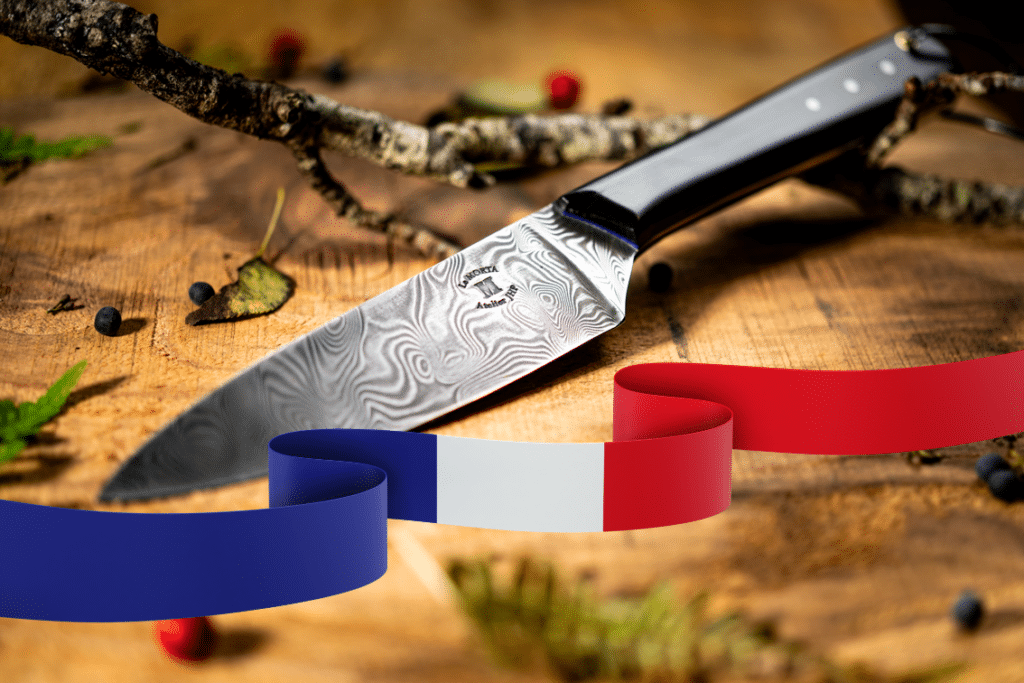
In response to the renewed interest in local consumption and short supply chains, numerous certifications have emerged. Each sector or region wants to showcase its uniqueness, which is normal after all.
Besides the well-known (Made In France, Fabriqué en France, or French manufacture), there are other labels.
The Origine France Guarantee is awarded by an independent organization and follows a specific set of specifications. It applies to products for which at least 50% of the cost price comes from France and which take on their essential characteristics in the country.
Promoting French Territories
Local authorities encourage artisans to promote local products and expertise.
For food products (dairy, fruits, etc.), the Controlled Designation of Origin (AOC) is used when all stages of the product are carried out according to recognized know-how in a specific geographical area.
Examples include:
- Produced in Brittany
- Espelette pepper
- Cotentin cider
The AOC is broader than the Protected Designation of Origin (PDO). It applies, for example, to forest products.
The Protected Designation of Origin (PDO) relates to food products. Recognized at the European level, it is equivalent to the AOP in France, which is essential for claiming the AOC.
Examples include:
- Camembert de Normandie
- Ardèche Chestnuts
- Grenoble Walnuts
Geographical indications (GI and PGI) are awarded to products linked to a geographical origin. Initially reserved for food and spirits, this certification is now extended to companies wishing to valorize their products and their know-how.
Examples include:
- Liffol’s furniture
- Bayonne ham
- Camargue rice
- Calais lace
- Brittany granite
- Guérande salt
- Chartreuse wood
Promoting Brand Values and Strategies
Finally, some logos highlight the work ethic:
- Positive Workspace for Made in France
- Lucie (personalized support)
- ESUS (social utility)
- OsmoZ (workplace well-being)
- CSR (Corporate Social and Environmental Responsibility)
- Service France Guaranteed
- Fair Trade
- Label Rouge (Red Label)
- RGE (Recognized Guarantor of the Environment)
- EPV (Living Heritage Company)
- Imprim’Vert
Different Types of Knives Made in France
An Exhaustive Range
France, a land of tradition and gastronomy, naturally excels in its offering of kitchen knives. Thus, French brands offer professional knives (meat knives, Japanese knives, paring knives, chef’s knives, fish knives, cheese knives, vegetable knives, bread knives).
The shapes of the blades vary to provide an exhaustive range:
- Skinning knives (straight blade)
- Boning knives (thin blade to separate bones from meat)
- Bleeding knives (shorter blade, about 15 cm)
- Filleting knives (thin blade sometimes curved upwards)
- Paring knives (long and flexible blade with a biased edge)
- Carving knives (or slicing knives) with a long, tapered blade
- Slicing knives
Versatile knives, pocket knives (folding knives), and table knives ensure the satisfaction of all consumer demands and needs.
🔪 For cooks, butchers, handymen, or adventurers, there’s a knife for every profession.
🔪 Opening oysters, setting up a bivouac, or slicing a birthday cake, there’s a knife for every action.
Our fixed knives include: Morta Trapper knives, utility knives, chef’s knives.
The different types of knives 🔪
Our folding knives include: Mini Morta massif, Morta massif, Morta raw forge, Morta massif Damascus (mini, standard, or XL).
Personalized Knives
French craftsmanship loves products and people. Personalized knives thus represent a significant part of the various collections. At Couteaux Morta, you can choose:
- The marking (name, initials as you wish according to a character limit)
- The font from 5 options
- The engraving of a pictogram, a mini artwork by Nicolas Peyron
- The inclusion of small mammoth ivory pieces (excluding table knives, stainless steel kitchen knives, and the Trapper model)
- The insertion of a blue vulcanized fiber edging on table knives, kitchen, Raw forge, and Damascus knives
Handmade knives leave room for the creative imagination of the cutler. What does your imagination suggest?
🤔 Did you know?
🔪 Sheaths and holsters for fixed and folding knives can also be personalized! Blue or black stitching, the choice is yours!
-

Case for folding knife
45,00 € This product has multiple variants. The options may be chosen on the product page -

Sheath for folding knife
45,00 € This product has multiple variants. The options may be chosen on the product page -

Sheaths for fixed knives
45,00 € This product has multiple variants. The options may be chosen on the product page
Preferred Purchasing Criteria of the French: Our Customer Reviews Reflect Current Trends
The numerous reviews from our customers show that the French adopt the following buying behaviors:
- The impulsive purchase for a model that catches the eye.
- The expert purchase by blade enthusiasts aiming for exceptional sharpness.
- The emotional purchase by a parent wishing to pass on a tradition, like the famous grandfather’s knife.
- The rational purchase based on need without other considerations.
- The purchase to please a connoisseur of the brand.
- The responsible purchase, opting for French to support a sustainable economy, etc.
This reflection is based on 485 Google reviews and 37 Trust Index reviews, as well as the kind feedback from our approximately 10,000 annual visitors.
The Made in France knife is more than a tradition; it’s a transmission of heritage and simple values. It’s about quality craftsmanship done with passion and expertise. Beauty lies in the details. These do not escape the notice of enthusiasts of beautiful handmade knives who make a sharp choice when they purchase emotion.
So, do you buy French, my friends?
Article written in France by the sharp pen of Christelle Lorant 🪶
9 key questions about the article
What are the major advantages of a Made in France knife?
Opting for a Made in France knife means choosing a high-quality, handcrafted product. French knifemakers pay particular attention to each stage of production, from the rigorous selection of steel to the polishing of the blade, guaranteeing an impeccable finish.
By choosing a French handcrafted knife, consumers also support the local economy and adhere to a responsible and ethical approach to consumption.
How does steel selection influence knife quality?
Knife steel is not chosen at random. It is the fruit of a rigorous selection process, aimed at offering you unrivalled resistance to corrosion and a cutting edge that lasts over time.
Stainless steel, for its strength, and Damascus steel, for its singular beauty and premium quality, are testimony to this perpetual quest for perfection.
This meticulous selection guarantees a precise, long-lasting edge, making each knife a reliable, top-of-the-range tool.
Why are Morta knives special?
Morta knives are distinguished by their exclusive use of Morta wood, a natural treasure resulting from the natural fossilization of 5,000-year-old oak trees in the Brière region.
This exceptional wood, with its deep shades ranging from brown to caramel, gives the knives a distinctive aesthetic and inimitable character. Each Morta knife is thus a window on history, a tangible connection with an ancient past.
In addition to their natural beauty and historical resonance, Morta knives are prized for their durability and lifetime warranty, embodying an unwavering commitment to quality and tradition.
How is France's history embodied in its knives?
Cutlery is deeply rooted in the country’s history, with towns like Thiers renowned for their cutlery heritage.
From the era of flint to the modern use of steel and bronze, each period has enriched the art of cutlery. This historical tradition is reflected in the quality, design and craftsmanship of our knives, making each piece a representation of French cultural heritage.
What is the economic importance of cutlery in France?
Cutlery represents a dynamic economic sector in France, with over 120 main manufacturers and around 1,600 employees. The sector has experienced significant growth, testifying to the growing appetite for quality knives made in France.
From traditional table knives to pocket knives, French cutlery continues to play an important role in the local and national economy.
Why buying a knife made in France is an ethical and responsible act?
Buying a Made in France knife goes beyond the simple act of purchasing; it’s an ethical and responsible approach. It means supporting the local economy, guaranteeing compliance with fair labor standards, and minimizing environmental impact through short distribution channels.
Choosing a French knife means investing in sustainability, quality and social commitment.
What criteria do the French choose when buying a knife?
The French value a variety of criteria when choosing a knife, from aesthetics to functionality. Whether for an everyday kitchen knife, a pocket knife or a high-end knife for special occasions, consumers are looking for knives that combine build quality, exceptional sharpness, elegant design and durability.
Personalized knives are also very popular.
What is the diversity of knives made in France?
The range of knives manufactured in France is vast and varied, meeting the needs of different users. From fine cutlery for the table to robust kitchen knives and versatile folding knives for outdoor use, each knife is designed with the same attention to detail and quality.
Why are Made in France labels important in the cutlery industry?
Made in France labels, such as Origine France, are essential for guaranteeing the authenticity and quality of French knives. They assure consumers that products are manufactured to strict standards, enhancing the value of craftsmanship and reinforcing confidence in French brands.
These labels also help preserve regional knife-making traditions and promote French excellence on the world market.


